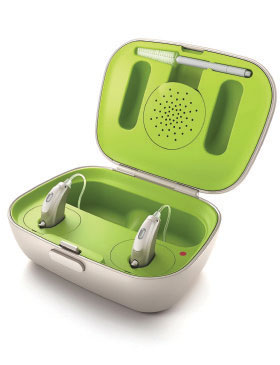Many of us are familiar with rechargeability when it comes to cellphones and laptops, but only recently has this feature become widely available in hearing aids. The convenience of this technology makes it appealing for many patients. At this time, most of the "Big 6" major hearing aid manufacturers have released a rechargeable device, all of which we work with at Johnson Audiology.
It can be difficult to navigate through the various available options to determine if rechargeability is the right feature for you. Before investing in a rechargeable solution, it is important to review each option with your audiologist to determine which device best meets your individual needs. Listed below is a brief overview of information to assist you in making this decision.
Types of Rechargeable Technology:
Nickel Metal Hydride (NiMH): NiMH batteries have been used with rechargeable hearing aids for several years. These are used with Signia's eCharger system. These batteries work well for some users, but have limited capacity. Compared to newer rechargeable systems, these batteries take longer to charge and cannot necessarily be counted on to last a full day. Until recently, these were the only widely available rechargeable hearing aid technology.
Lithium-ion: Major manufacturers Signia and Phonak both offer hearing aids with rechargeable Lithium-ion batteries, which are the same type of batteries used in many smart phones. Lithium-ion rechargeable hearing aids are easy to use and easy to recharge. It takes about 3 hours to charge these devices completely and they will remain charged for approximately 24 hours. Like traditional Zinc Air disposable batteries, Lithium-ion batteries are toxic. Due to additional safety concerns such as flammability, Lithium-ion batteries must be completely sealed within the casing of the hearing aid. This means that these batteries cannot be removed by the user or audiologist and must be sent to the manufacturer to be replaced. Because Lithium-ion batteries are completely encased, these hearing aids are not compatible with disposable batteries. Lithium-ion rechargeable hearing aids are a great option for users looking for a simple, long lasting rechargeable battery.
Zpower: Silver-Zinc rechargeable technology, created by "ZPower," is currently compatible with devices from four major manufacturers: ReSound, Oticon, Unitron, and Starkey. Compatible hearing aids from these manufacturers can be converted to rechargeable technology at any time by simply replacing the battery door in your audiologist's office and inserting a special ZPower battery. ZPower batteries are non-toxic, non-flammable, and are estimated to last a full day on one charge. Although their maximum life is not as long as that of Lithium-ion batteries, they will easily last a full day for the majority of user. In addition, Zpower batteries do not experience excessive battery drain while utilizing wireless streaming. The Zpower battery door is compatible with zinc air disposable batteries, meaning users will have the option of switching between rechargeable and disposable batteries as needed.
Considerations when Choosing a Rechargeable Option:
No need to change batteries: Because of the small size of hearing aid batteries and battery doors, it can be difficult for patients with vision problems or dexterity issues to routinely change batteries. Hearing aid chargers are designed very simply in order to make the charging process as easy as possible for users.
Battery life: The longest lasting rechargeable batteries only last an estimated 24 hours per charge, guaranteeing a full day of use. If users are charging their batteries every night, they may never even hear the "low battery warning" from their hearing aids! Patients who enjoy activities like camping or do not have consistent access to an outlet each night can still benefit from rechargeable options. Zpower rechargeable hearing aids give such patients the option to use disposable batteries when necessary. Some manufacturers also offer portable charger battery packs as an accessory – these provide an option for charging rechargeable batteries when you do not have access to an outlet for several days at a time.
Cost: There is no significant cost difference between disposable and rechargeable batteries. Hearing aid users are more likely to choose rechargeable technology for their convenience an ease of use and not due to financial reasons.
Feature and style options: Rechargeability is currently available in the behind-the-ear style. Some features, such as Direct-to-iPhone streaming, are not yet available in every rechargeable device. As technology improves, however, rechargeable hearing aids are quickly becoming increasingly sophisticated and flexible.
It is important to work closely with your audiologist to determine which hearing aid style and features are most appropriate for your specific hearing loss and lifestyle demands. The convenience and ease of use of rechargeability make this a valuable feature for many users. At Johnson Audiology, our audiologists will work with you to determine the best option to meet your needs.
Noteworthy:
Before investing in a rechargeable solution, it is important to review each option with your audiologist to determine which device best meets your individual needs.
MORE INFORMATION
For more information about Johnson Audiology and their services or to schedule a consultation or appointment, call 423-710-1432 or visit johnsonaudiology.com.

